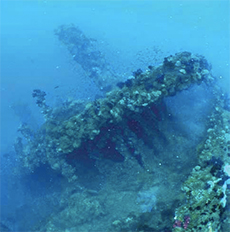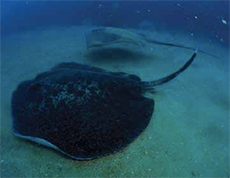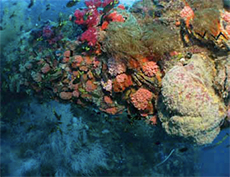




| Home | Features | Club Nights | Underwater Pics | Feedback | Non-Celebrity Diver | Events | 8 August 2025 |
| Blog | Archive | Medical FAQs | Competitions | Travel Offers | The Crew | Contact Us | MDC | LDC |

|

|
 
 |
      ISSUE 14 ARCHIVE - DIVING THE SS YONGALAHoward SawyerThe Mysterious Tale of The Racehorse, The Wreck, and The Death of The Princess Bride.I don't believe in ghosts, but if I did, they'd be here. You can still see their faces. They're not the sort of faces you see anymore, although that's not because these men are dead, but rather because in the century since their passing, we've traded their naivety for our 'sophistication'. And that shows, principally from the neck up. And we don't do moustaches like that these days. So here they are, sepia tinged, large as life, stuck to a wall in memoriam. The officers of the SS Yongala, posed for the photographer, captured for posterity, now benignly watching over the glass cased model of their beautiful Edwardian ship. The small gallery in the Maritime Museum of Townsville creaks underfoot. It’s like a ship inside and out, so no great surprise to discover this was once the office of the Pier Master in a past life, before they moved the building to its present position on Palmer Street, overlooking Ross Creek. Here, lovingly curated, they house some of the artefacts recovered from the wreck; deformed skylights and portholes, stained glassware and porcelain, the bell, a photograph of the racehorse, ‘Moonshine’, Yongala’s most celebrated victim, and an artist’s impression of the ship on the brink of oblivion, swamped by the sea. I can barely bring myself to look at Bill Knight, head cocked with a trace of a smile. He looks too kind for this end. Tomorrow I’m going to dive the ship that became his grave, and I feel guilty, because I can’t wait. The Greyhound bus takes me south along the Bruce Highway towards the small town of Ayr, just over an hour away. I journey in the company of Max Gleeson’s detailed account of the SS Yongala, purchased at the Maritime Museum gift shop. She was commissioned, along with a sister ship, Grantala, by the Adelaide Steamship Company, to meet the demand of the Gold Rush coastal routes in the late 1890 s. Built in Newcastle on Tyne, launched in 1903, she was a beautiful 363 foot long vessel, state of the art for her day, fitted out in walnut and oak, with the capacity to carry 110 first class and 130 second class passengers, plus cargo. She boasted staterooms, smoking room, music room, saloon, and a magnificent staircase in the dining room, all whisked along in fine style at an impressive 16 knots. Her name came from the Aboriginal word meaning broad watering place , in line with the company s policy to christen their ships in the indigenous language. As the Gold Rush panned out in Western Australia, the company switched to ply the northern coast, and Yongala commenced the Melbourne to Cairns run in 1907, with Captain Knight in command. Born in Bromley, England, in 1852, sailor William Knight came to Australia and patiently learnt his trade. His first command, the steamer Glanworth, didn’t fare too well, as she ran aground on only his second voyage. Nonetheless, having served a six month suspension, he was taken on as a mate by his new employers, the Adelaide Steamship Company, and subsequently given command of their steamer, Wollowra. Knight duly became an experienced, respected captain, and by 1901, his portrait was centre stage amongst his contemporaries in the line’s promotional literature. The bus pulls into the crossroads at Ayr, and within a minute I’m left standing alone in single storey rural Australia. A radio plays to itself through an open window. I call Yongala Dive. They’ll send someone to pick me up when the dive boat returns, in an hour, maybe two. No drama. In a scene straight out of a Coen brothers movie, I wander across the deserted street to the supermarket. I’m the only customer. Then I find treasure for dinner; a tin of Stagg Chilli. I’d give this place UNESCO World Heritage status, no question. Back on my bench at the bus stop I turn the page to Yongala’s final voyage. She departed Melbourne for Cairns on the 14th March 1911, making her usual scheduled stops, and at Brisbane received a racehorse trainer with his new acquisition, ‘Moonshine’. Livestock as freight was not unusual, and the horse joined the red Lincoln bull already aboard. Yongala departed Flat-top Island for the 200 odd mile leg north to Townsville, early afternoon on the 23rd March, and was sighted five hours later by a lighthouse keeper in worsening weather. The vessel and the one hundred and twenty one souls on board were never seen again. Other shipping sought shelter having received storm warnings, but the Yongala, without radio, sailed straight into a cyclone. Overdue at Townsville, the assumption was that Knight had taken refuge, but when other ships arrived and there was still no word, an extensive land and sea search began. The lighthouse keeper at Bowling Cape Green found a bag of chaff on the beach, and a steamer arrived in Townsville having recovered detritus, including an inscribed door from Yongala’s promenade deck to the music room. Then the badly decomposed remains of a horse, presumably ‘Moonshine’ was washed ashore. With the ship now lost beyond doubt, a disaster fund was launched, show biz got involved, and over time, with no sign of the wreck, Yongala slipped into maritime mythology. There was the odd ghost story featuring a rusty doppelgänger, but it wasn’t until 1947, when the Navy took a closer look at an obstruction discovered by minesweepers during the war, that they realised they’d found a wreck, and one with dimensions that matched Yongala. Obviously when the Navy’s discovery off Bowling Cape Green was made public, everyone assumed Yongala had been found. It was left to the Queensland Underwater Research Group, with their new scuba equipment, to finally establish the wreck’s identity. In 1958 they recovered a safe, and although the contents had been reduced to sludge, the serial number was sent to the manufacturer in England, who duly confirmed that the safe did indeed come from Yongala. With the mystery finally solved, the scuba club dumped the artefact into the river. And then went to the pub for a cold one. Probably. Christina of Yongala Dive picks me up for the fifteen minute scenic drive to Alva Beach. There’s not even a crossroads here, just a small residential community bolstered by the transient tourists of the local trailer park. I’ve arrived in the Twilight Zone on the fringe of a beautiful white beach. The Yongala Divers Lodge accommodates a dozen divers in neat dorms, or a double room, with a lounge, kitchen, and a sunset thrown in. The dive shop is downstairs, so you can roll out of bed, grab some brekkie, and you’re good to go. Having sorted your kit, the polished dive briefing takes place under the shade in the garden over coffee and tea, then it’s into the 4WD to off-road along the beach to the waiting ‘Yongala Express’, a 10m rigid inflatable for just 12 divers, guides and crew. We’re tractored off the beach into the surf, skipper Bryan navigates the shifting sand bars, then opens the throttle for the exhilarating thirty minute dash to the wreck. And this is where diving from Alva Beach with Yongala Dive becomes a no brainer. The boats from Townsville only run when full, and with their trip to the wreck taking three hours over choppy water, when they do eventually arrive, the majority of their clients hang off the back to indulge in a bout of impromptu fish feeding. We suit up. Thin hoods are offered to ward off the odd stinger in the water and I have the pleasure of rolling in first with buddy Jamie, a dive instructor from Sydney. We descend down the line as briefed, although there’s little discernible current on this dive, through blue water with at least 15m visibility; the bow at 14m is clearly visible from the surface. I’d seen plenty of underwater footage of the wreck, (the staff at the Townsville Maritime Museum will put on a 40 minute DVD for you to watch during your visit), and enviously sat through plenty of first hand accounts, but in truth nothing prepares you for the amount of marine life on the wreck. Dive operators who sink ships to make artificial reefs can only dream of this. Every square inch is occupied with a greater variety of coral than you will find on most reefs. This is like a sci-fi world for fish. For them, Yongala is Mega-City One. We descend over the bow, across the deck, the carcass upright, listing to starboard, and past the forward cargo hold, which according to the briefing now contains some femur bones. Penetration of the wreck is now forbidden due to its fragility, but you can peer in from outside with a torch. Continuing our ‘loop’ tour requires concentration to avoid ploughing into the prolific black coral trees that have supplanted the lifeboat davits. The wreck moves. Everywhere. It heaves with life. Shoals bomb back and forth, trevally, jacks, yellow-tailed fusiliers and cardinal fish. The small fry flee from the path of the patrolling schoolmaster; the Humphead Maori wrasse. A hawksbill turtle grazes on the wreck, seemingly oblivious to our close quarters fascination, although in truth, ignoring us in favour of food. We drop down onto the flat white sandy bottom, between masts that lie like fallen maypoles, to examine a pair of marbled rays. Again they afford us scant attention. The wreck’s inhabitants are so unconcerned with our presence, Yongala might well be a lost outpost of the Galapagos. As I follow Jamie along the starboard side, he’s shadowed by an olive sea snake that bounds through the water like an enthusiastic puppy. Another travels across the deck, poses momentarily for a photo opportunity, then sells me a dummy and sashays away between my legs. First time I’ve been ‘nutmeged’ by a sea snake. The stern rears above us, a ceiling bedecked with jewellery growth, beneath which the rank and file trevally screen a huge Flowery cod. This is the maximum depth of the dive with my computer registering 28.3m, hand-on- the-sand. The rudder lies to the port side, but the ‘Wow’ factor is lifting off the bottom and hanging back to view the sweep of the stern, blurred by frenetic fish traffic. As we ascend to cover the port side it’s possible to peer into the bowels of the wreck to spy the cast iron bath and toilets, and the obligatory decorative anemone fish, before coming along the companionways to the coral grotto that was once the first class dining room. As we near the end of the dive and return to the line at the bow, there’s still plenty of time to observe an impromptu cleaning station for batfish. This is a stunning dive, and it’s no surprise that diving legend Valerie Taylor said if she had just one more dive in her life, she would choose Yongala. Tragically, Christina Mae Watson didn’t get a choice. She’d only taken up scuba diving at her fiancee’s insistence. After her fairy tale wedding in Alabama in 2003, she and husband David ‘Gabe’ Watson travelled to Australia for their honeymoon, including a Queensland liveaboard and a dive on Yongala. Watson, a qualified rescue diver claimed ‘Tina’ quickly got into trouble, then sank to the bottom. Unable to save her, he decided to ascend and return to the boat for help. She was recovered from the seabed by a dive guide and brought to the surface, where attempts to resuscitate her failed. It might have been a tragic accident, but there were inconsistencies in Watson’s statement to the Townsville police. His description of his dive did not match the profile of his dive computer, Tina’s equipment was in good order, and tellingly, another diver claimed to have witnessed him holding his bride in a bear hug. In a further macabre twist that brought the story to international prominence, a photograph from the dive emerged with Tina’s body unintentionally captured in the background, prone on the seabed. She had been married for just 11 days. In 2007 the Queensland government launched an inquest, and the following June the Townsville coroner returned a verdict. The court charged Watson with Tina’s murder, and a warrant was issued for his arrest. It was alleged that Watson had restrained his wife underwater, turned off her air until she lost consciousness, then turned the air back on, before making a calm ascent to the surface to raise the alarm. Tina’s family suggested the motive behind her death was a life insurance policy, which he is alleged to have asked his wife to increase in the weeks prior to the wedding. Back in Alabama, out of reach of the Queensland authorities, life went on for Watson. He remarried a Tina lookie-likey and periodically visited his first wife’s grave to remove the flowers left by her family. He was finally caught on a police surveillance camera using bolt cutters to cut away floral tributes that had been secured with wire to prevent vandalism. For reasons unknown, he had Tina’s casket dug up, moved to another part of the cemetery and reburied. To this day there’s still no headstone. Alabama state law prohibits Tina’s family from providing one. Having followed the case, it gave diving the wreck a contemporary resonance beyond the names and faces in the Townsville Maritime Museum. And in truth I remember being a novice diver, and feeling trepidation before rolling in. Only unlike Tina, I didn’t have anyone pushing me. Coincidentally around the time I was completing my last dive on the wreck, Watson was handing himself in to the police in Brisbane, having voluntarily returned to Australia to clear his name. His American lawyer, Bob Austin is reported to have said of his client, “He wants to get it over with.” Tina’s family flew to Australia for the trial in June 2009, hoping that they might finally get answers. They were going to be disappointed. It didn’t make sense that after five and a half years Watson would just decide to voluntarily return to face the possibility of a life sentence for murder, and consequently the prosecution accepted a deal for him to plead guilty to the lesser charge of manslaughter. This meant there’d be no trial, and he’d only serve eighteen months in prison of a four and a half year term. So he’ll be out by the time you read this, and I know what you’re thinking; he should’ve got eighteen months just for using the bolt cutters to remove the flowers from the grave. Tina’s father, Tommy Thomas, stands outside the Brisbane Supreme Court. He has grey hair and a moustache, the like of which you don’t see these days. He says the outcome is “an embarrassment. “We believe that Gave Watson murdered our daughter and we will continue to believe that. This is not justice. This is not over.” I hope he’s right. Behind the hurt, Tommy Thomas looks too kind for this end. |